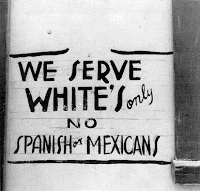Please bear another reference to the "N" word as Bronsbil Estacion takes a look at the cover of this master's thesis written by Ricardo Malbrew, a college student at the time who visited Brownsville, Texas in 2006. Let's examine how it came about but first we'll talk about the title.
Here are three samples of signs we might have occasionally seen if we lived during the Jim Crow era mandated laws of racial segregation which were overruled by the Civil Rights Act of 1964 and Voting Rights Act of 1965. In Brownsville of 1906 whites and Mexicans got along well enough and both some shared bigoted attitudes against African-Americans just like the rest of the country. In Brownsville some business owners posted signs telling customers "No Niggers or Dogs Allowed" to send a clear message to black soldiers they were unwelcome in their bars or stores.
1949 Corpus Christi, Texas
We'll examine race relations between blacks, whites and browns in a future post.
In 2006 UTB/TSC publications printed the image on invitations for a memorial service to commemorate the 100th anniversary of the 1906 Brownsville Raid also known as the Brownsville Affair or Brownsville Affray. I was in transition as I resigned my position with the archival wing of the college library to work for a historic museum and working simultaneously with the museum and college for this commemorative event.
Here's a photo of 10th Cavalry Buffalo Soldiers late 1800s found on the internet.
Here's the same image reversed horizontally.
The image almost fits perfectly in the silhouetted shapes of the raiders.
Here is the concept. The image of Buffalo Soldiers was deliberately sought to create a simple ambiguous image to accept the fact we will never know who the raiders were. To the casual observer the shapes resemble; some with men with rifles but whether their hats are civilian or military is not so clear especially if you are only familiar with hats worn by soldiers like those we see in Robert Runyon photos from the 1910's and 20's which are shaped differently.
The setting is from a Robert Runyon postcard showing the main entrance to Fort Brown which faced the city and barracks were soldiers were quartered. It isn't to pinpoint the spot where the raid was launched but rather to illustrate the close proximity the fort and town to each other.
The blood-red sky doesn't symbolize the blood spilled that night as it wasn't a massacre or anything like that. Only one man was killed and another had to have his arm amputated. The red represents heat and anger; that's all. August is one of the hottest months in Brownsville and the kind of environment where tempers can flare up in short-time. Inserting a blood-red moon would have been a cliche' and the absence of a moon reinforces the fact that no one could have positively identified the raiders which us crucial in this case.
Mr. Malbrew later contacted me and asked if he could use the image for the cover of his thesis.
I haven't read or purchased the book but if it was re-titled as "Brownsville Revisited" to eliminate the "N" word from the controversial title then you can read it here for FREE by clicking on link below:










No comments:
Post a Comment